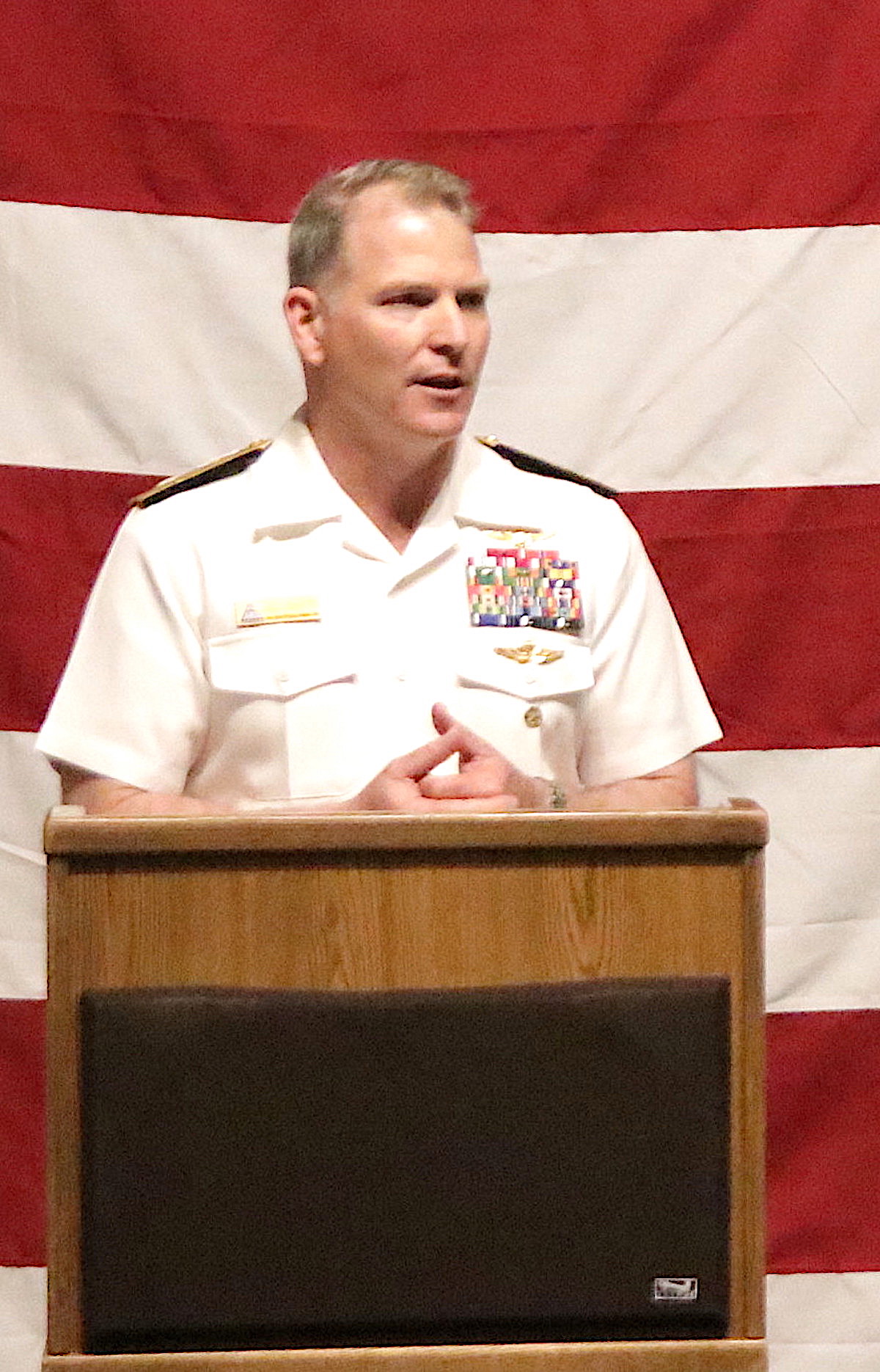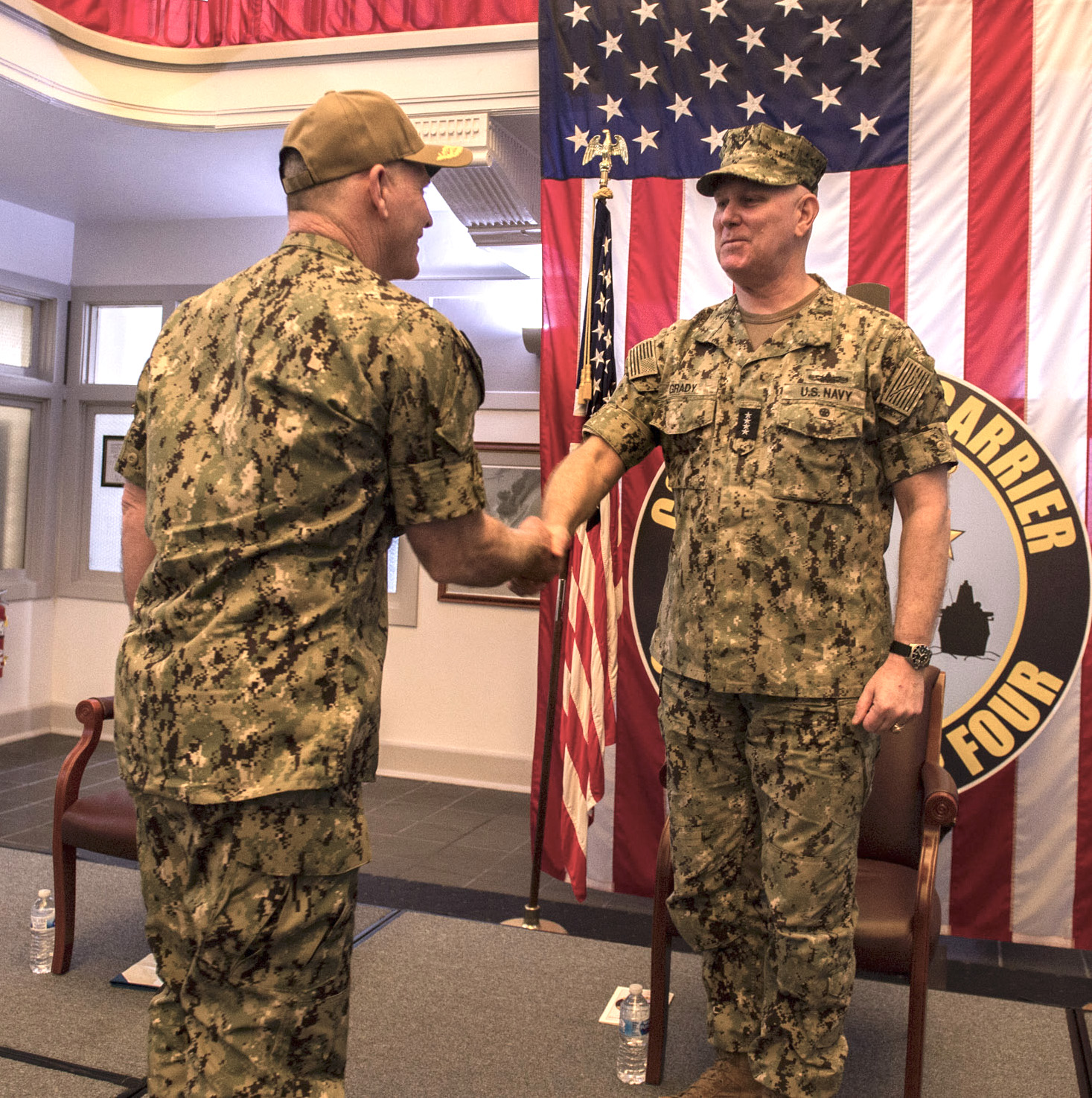Adm. Christopher Grady, left, commander, U.S. Fleet Forces Command, speaks during a change of command ceremony held at Carrier Strike Group Four (CSG-4) headquarters. Rear Adm. Richard Brophy, far right, relieved Rear Adm. Andrew Loiselle as commander of CSG-4.
With the celebration last weekend of the Fourth of July and Churchill County’s remembrance of patriotism, apple pie, and Americana, the Naval Aviation Warfighting Development Center has a big voice in training to keep the United States safe.
The success for the past two years of NAWDC’s mission fell on Rear Adm. Richard T. Brophy, who is now with Carrier Strike Group FOUR Norfolk, Va., home of the largest naval base in the world.
It’s not the ships that guide the Navy nor the aircraft that glide across the azure horizon. It’s the people. A Zoom conference with more than 100 midshipmen from the U.S. Naval Academy energized Brophy before he discussed his time in Fallon.
“Their questions are brilliant, and these young officers are bright,” Brophy exclaimed. “I’m excited about the future of our Navy.”
More so is the legacy his family is family has created of men and women who want to serve their country.
“I’m a fourth-generation naval aviator,” he said.
His wife Kara also attended the academy and spent five years on active duty with the Navy and hails from a family of naval veterans.Her father served multiple tours in Vietnam, and grandfather, James H. Flatley Jr., was a World War II ace. Their daughter, Claire, wrapped up her first year at the academy in Annapolis, Md., and older brother Tommy graduated in May and is following in his father’s footsteps to become a naval aviator. The Brophy family’s closeness thrives although Admiral Brophy is away from home. Additionally, he tells anyone transferring to Fallon they will enjoy the small-community atmosphere. From a holiday party hosted by the Brophys and attended by the community to COVID-19, they witnessed the pandemic’s effects, good and bad. Because her high school went to distance learning, and the academy shut down for the spring semester 2020, both Claire and Tommy returned to Fallon. The empty-nesters soon had company. Steve Ranson/LVN
Steve Ranson/LVN
Rear Adm. Richard Brophy speaks at a change of command ceremony at the Naval Aviation Warfighting Development Center in 2019.
“The pride you have here with the Navy is evident,” he said. “it’s one of the reasons you see repeat offenders here.”
Brophy then clarified himself, jokingly saying repeat offenders are those naval personnel who can’t wait to return to Fallon.
The Brophys took advantage of Churchill County’s uniqueness by hiking or traveling to a different area. During Christmas, the family spent Christmas at a friend’s house at Incline Village.
“Ah, great memories,” Brophy sighed.
Brophy, though, said he would like to return to Fallon when the Top Gun sequel movie with Tom Cruise is shown. Many of the scenes were filmed at the air station and surrounding areas.
Brophy, who assumed command in Fallon in 2019, faced challenges due to mission requirements and a subtle visitor that took control of the world, the coronavirus. The Carmel, Calif., native, though, felt like he was close to his boyhood home, a six-hour car ride from the alfalfa fields of the Lahontan Valley. Now, as to what happens to many naval officers who complete their command at NAWDC, Brophy now leads Carrier Strike Group FOUR (CSG-4) at Norfolk.
“We’re the trainer of all strike groups when they deploy,” Brophy said.
With the completion of the change of command, Brophy followed in the steps of his predecessor of NAWDC, Rear Adm. Daniel Cheever, who went to Norfolk. Now Vice Adm. Scott Conn took command of CSG-4, and now he serves as the commander of Third Fleet.
Brophy, though, contributed what his predecessors instilled at NAWDC: To make it a destination where naval aviators and support personnel want to receive their next set of orders.
“Quality people are coming up here because of the mission,” Brophy pointed out.
During his two years at Fallon, Brophy said NAWDC revamped the syllabus beginning with an air wing that trained at Fallon and then became challenged when training with the COVOD-19 requirements.
“We issued no training,” Brophy said. “We stepped up our protocols on everything. It was had to roll out (the training) but we fought through it.”
“We had no outbreaks,” Brophy added. MCS3 Isaac Maxwell /U.S. Navy photo
MCS3 Isaac Maxwell /U.S. Navy photo
Adm. Christopher Grady Commander, U.S. Fleet Forces Command, congratulates Rear Adm. Richard Brophy after assuming command of Carrier Strike Group Four (CSG-4).
Before leaving NAWDC, Brophy qualified in the jet.
“It’s a great airplane,” Brophy said.
Even before he set boots on the ground in Fallon, Brophy became a face and voice of the Fallon Range Training Complex modernization and expansion. Since 2016, both the Navy and Air Force have both called for an expansion of both the Nevada Test and Training Range in southern Nevada and the Fallon Range Training Complex south and east of Fallon in addition to the lease extension. Nevada Sen. Catherine Cortez Masto, D-Nev., said the status quo extensions for 25 years at both the Navy and Nevada Test and Training ranges were included in the final conference version of the Fiscal Year 2021 National Defense Authorization Act.
The current Navy request, though, had included a withdrawal of an additional 604,789 acres of additional public land and an acquisition of about 65,160 acres of non-federal land for the range modernization and expansion. It was not included in the NDAA, and a local committee has begun to examine key components of the expansion request. The current Navy request includes a withdrawal of an additional 604,789 acres of additional public land and an acquisition of about 65,160 acres of non-federal land for the range modernization and expansion.
“It is still a No. 1 priority,” he said. “It’s still a requirement we need. The requirements haven’t gone away.”
Brophy said the range modernization is something the Navy needed five years ago. His enthusiasm of the Navy’s future for training and attracting the best men and women for the mission keeps him optimistic.
Brophy’s focus on the Navy’s mission now takes him from the hot, searing desert of Northern Nevada to the coast of the Atlantic Ocean.
Before a carrier strike group deploys, it completes training off the coast from Norfolk to ensure readiness. According to its website, “CSG-4 trains and delivers combat–ready naval forces to U.S. 2nd Fleet and U.S. Fleet Forces Command, which are capable of conducting full-spectrum integrated maritime, joint, and combined operations in support of U.S. national interests. CSG-4 conducts training through exercises that create a realistic training environment and includes academic, synthetic and live training.”
After the change of command for the CSG-4, Brophy noted the legacy of deploying units that meet the fleet’s demands.
Brophy said a carrier strike group includes the carrier and carrier air wing, destroyer squadron and a cruiser.
“I’m honored to be able to lead this team of exceptional sailors, Marines and civilians as they continue this critical mission of ensuring warfighting readiness,” he said.
 Steve Ranson/LVN
Steve Ranson/LVN MCS3 Isaac Maxwell /U.S. Navy photo
MCS3 Isaac Maxwell /U.S. Navy photo